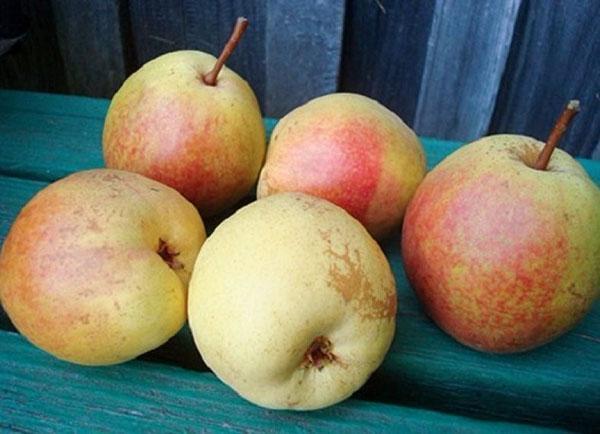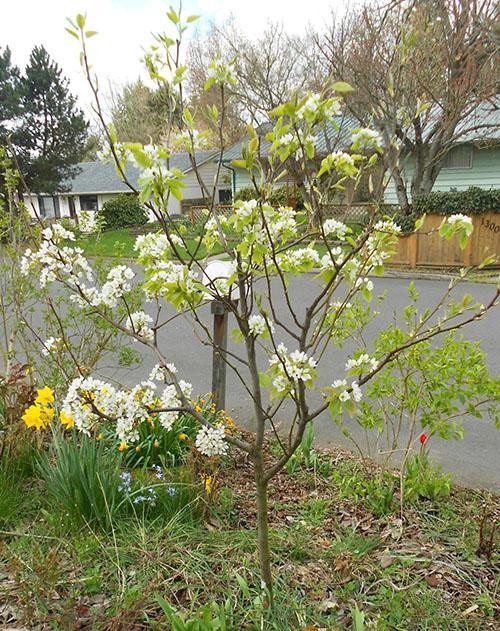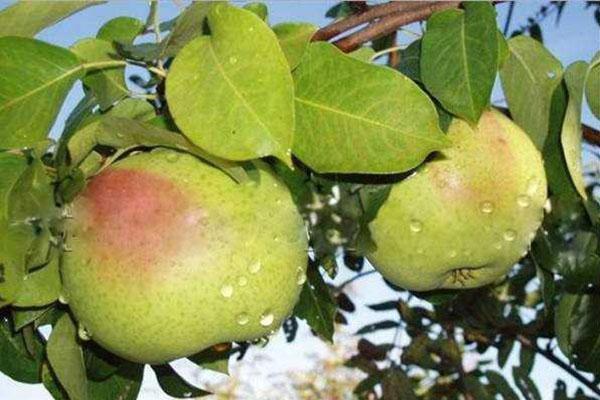Sweet juicy pear of the Rogneda variety at their summer cottage
 When choosing seedlings for a personal plot, the gardener takes into account the taste of the fruit, yield, plant endurance. The Rogneda pear is one of the best fruit trees for the Central Region of Russia.
When choosing seedlings for a personal plot, the gardener takes into account the taste of the fruit, yield, plant endurance. The Rogneda pear is one of the best fruit trees for the Central Region of Russia.
The aromatic sweet fruit is easily recognizable due to its unusual rounded shape. Autumn pears are rarely affected by scab and rot, and trees are excellent at tolerating frosty winters.
The origin of the Rogneda pear variety

In the late 90s, a group of scientists from the Moscow Agricultural Academy named after V.I. KA Timiryazeva presented the Rogneda pear variety for state trials. Plants of the Tema variety, which is widespread in the Far East, and Forest beauty originally from Belgium.
From the parent couple, the novelty received excellent winter hardiness, high yield and good consumer qualities of the fruit.
Since 2001, the pear of the obtained variety has been included in the State Register for the Central Region. Since then, Rogneda has become very popular among amateur gardeners in Moscow and neighboring regions.
Description of pear varieties Rogneda
 Pear seedlings enter the amateur garden at the age of 1-3 years. Rogneda is a fast growing variety. The first ovaries appear already on 4-year-old trees.
Pear seedlings enter the amateur garden at the age of 1-3 years. Rogneda is a fast growing variety. The first ovaries appear already on 4-year-old trees.
The plant has an average growth rate. Although the buds are awakening very actively, few shoots are formed.
An adult tree has a thin, round or oval crown, consisting of strong, weakly curved branches. Geniculate young shoots are covered with greenish-brown bark, which in the sun takes on a purple or purple hue.
According to the description, the Rogneda pear has medium-sized obovate leaves with jagged edges and fairly strong cuttings. A little earlier than the foliage, large pinkish-white pear flowers open up. The ovaries are formed mainly on the ringlets.
The variety is characterized by a generous yield of the harvest, the weakest fruits are removed, which increases the quality of the growing pears, helps to avoid a sharp frequency of fruiting.
Rogneda pears are ready for harvest at the end of August. Ripe fruits of an almost round shape by this time have a light yellow color and a smooth, shiny surface. Sometimes the side exposed to the sun turns reddish from the blush. Despite the thick short stalk, fruits weighing from 120 to 140 grams can be massively crumbled, so you should not hesitate with harvesting.
 After a few days of ripening, the pears are ready for fresh consumption. Under a medium-thick skin with small subcutaneous punctures, there is a juicy pulp with a hint of baked milk. Pears have a bright nutmeg aroma and a sweet, slightly oily flavor. In the middle lane, fruits accumulate up to 7.5% of sugars, while the acid content does not exceed 0.15%.
After a few days of ripening, the pears are ready for fresh consumption. Under a medium-thick skin with small subcutaneous punctures, there is a juicy pulp with a hint of baked milk. Pears have a bright nutmeg aroma and a sweet, slightly oily flavor. In the middle lane, fruits accumulate up to 7.5% of sugars, while the acid content does not exceed 0.15%.
The fruits harvested on time in the refrigerator retain their freshness for up to two months. Pears can be used in home cooking, for making confectionery and preparations for the winter.
Advantages and disadvantages of the Rogneda pear variety

In central Russia, the Rogneda variety shows its best qualities, which can be safely attributed to:
- excellent frost resistance;
- high productivity;
- decent taste of ripe fruits;
- resistance to scab and fruit rot that often affects fruit trees.
These qualities have determined the high popularity of the variety among owners of household plots. Summer residents, forced to save every square meter, estimated the average size of the trees. However, breeders have not yet managed to breed crops devoid of flaws.
Pears are completely or partially self-fertile. The Rogneda variety is no exception. Don't expect a bountiful harvest if there are no other pear trees in the area blooming at the same time.
Plants will serve as pollinators for Rogned pears varieties Chizhovskaya, Memory of Anzin, Milada and Vidnaya.
Experienced gardeners with experience in growing pears of this variety point out among the weaknesses:
- crumbling of ripe pears;
- the frequency of fruiting of mature trees.
Rogned pears taste good, but the fruit is light in color, which makes it less valuable for commercial cultivation.
Planting and caring for Rogneda pear varieties
 For pear trees to delight the gardener, they need proper conditions for growth and fruiting. For seedlings, choose a well-lit place with light fertile soil. Pears cannot tolerate the proximity of groundwater, stagnant moisture or waterlogging. Therefore, before planting, drainage is established in such areas and artificial hills are made.
For pear trees to delight the gardener, they need proper conditions for growth and fruiting. For seedlings, choose a well-lit place with light fertile soil. Pears cannot tolerate the proximity of groundwater, stagnant moisture or waterlogging. Therefore, before planting, drainage is established in such areas and artificial hills are made.
Seedlings with a closed root system can be transferred into the ground from early spring to mid-autumn. Roots that are open or packed in peat are more vulnerable. Such trees are planted in the spring, until the leaves have opened, or in the fall, before the onset of cold weather. Pre-inspect the roots, remove damaged or rotten ones.
You can speed up survival by immersing the lower part of the tree in warm water with the addition of a growth stimulator for a couple of hours before planting.
Planting pits with a depth and diameter of at least 80 cm are prepared in advance so that the soil has time to settle. Two buckets of sand and high-quality humus or well-rotted one are added to the garden soil manure... The components are enriched with 800 grams of sifted wood ash. Then the composition is mixed well. If necessary, the soil is deacidified with dolomite flour, bringing the pH to 5.6–6 units.
Planting a seedling:
- A small cone is poured from the resulting soil at the bottom of the pit, along which the straightened roots of the seedling are carefully laid out.
- To give the tree stability, a solid support is strengthened in the pit.
- The pit is filled up, making sure that the root collar is 3–5 cm above ground level.
- The near-trunk circle is watered abundantly, tamped, and then mulched.
Caring for a Rogneda pear after planting includes regular watering, feeding and weeding. The plant requires special attention in the first year.
If a young pear is blooming, the buds must be removed. Weekly watering, especially in the hot season, mulching and removing weeds from under the crown stimulates the development of the fruit tree.
Although the variety is winter-hardy, before the onset of persistent cold weather, care should be taken to protect the young garden. The trunk is wrapped in a covering material. It will not only protect the pear from low temperatures, prevent rodents from eating bark, but also prevent the formation of spring burns.